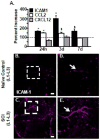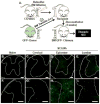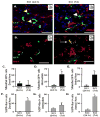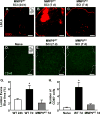Lumbar Myeloid Cell Trafficking into Locomotor Networks after Thoracic Spinal Cord Injury
- PMID: 27191729
- PMCID: PMC4930359
- DOI: 10.1016/j.expneurol.2016.05.019
Lumbar Myeloid Cell Trafficking into Locomotor Networks after Thoracic Spinal Cord Injury
Abstract
Spinal cord injury (SCI) promotes inflammation along the neuroaxis that jeopardizes plasticity, intrinsic repair and recovery. While inflammation at the injury site is well-established, less is known within remote spinal networks. The presence of bone marrow-derived immune (myeloid) cells in these areas may further impede functional recovery. Previously, high levels of the gelatinase, matrix metalloproteinase-9 (MMP-9) occurred within the lumbar enlargement after thoracic SCI and impeded activity-dependent recovery. Since SCI-induced MMP-9 potentially increases vascular permeability, myeloid cell infiltration may drive inflammatory toxicity in locomotor networks. Therefore, we examined neurovascular reactivity and myeloid cell infiltration in the lumbar cord after thoracic SCI. We show evidence of region-specific recruitment of myeloid cells into the lumbar but not cervical region. Myeloid infiltration occurred with concomitant increases in chemoattractants (CCL2) and cell adhesion molecules (ICAM-1) around lumbar vasculature 24h and 7days post injury. Bone marrow GFP chimeric mice established robust infiltration of bone marrow-derived myeloid cells into the lumbar gray matter 24h after SCI. This cell infiltration occurred when the blood-spinal cord barrier was intact, suggesting active recruitment across the endothelium. Myeloid cells persisted as ramified macrophages at 7days post injury in parallel with increased inhibitory GAD67 labeling. Importantly, macrophage infiltration required MMP-9.
Keywords: Blood brain barrier; Inflammation; MMP-9; Macrophage; Spinal cord injury.
Copyright © 2016 Elsevier Inc. All rights reserved.
Conflict of interest statement
Conflict of Interest Statement: The authors have declared that no conflict of interest exists.
Figures








Similar articles
-
Elevated MMP-9 in the lumbar cord early after thoracic spinal cord injury impedes motor relearning in mice.J Neurosci. 2013 Aug 7;33(32):13101-11. doi: 10.1523/JNEUROSCI.1576-13.2013. J Neurosci. 2013. PMID: 23926264 Free PMC article.
-
Matrix metalloproteinase-9 and stromal cell-derived factor-1 act synergistically to support migration of blood-borne monocytes into the injured spinal cord.J Neurosci. 2011 Nov 2;31(44):15894-903. doi: 10.1523/JNEUROSCI.3943-11.2011. J Neurosci. 2011. PMID: 22049432 Free PMC article.
-
Bone Marrow-Derived Monocytes Drive the Inflammatory Microenvironment in Local and Remote Regions after Thoracic Spinal Cord Injury.J Neurotrauma. 2019 Mar 19;36(6):937-949. doi: 10.1089/neu.2018.5806. Epub 2018 Oct 6. J Neurotrauma. 2019. PMID: 30014767 Free PMC article.
-
Neuromodulation of the lumbar spinal locomotor circuit.Neurosurg Clin N Am. 2014 Jan;25(1):15-23. doi: 10.1016/j.nec.2013.08.007. Epub 2013 Oct 11. Neurosurg Clin N Am. 2014. PMID: 24262896 Review.
-
Emerging concepts in myeloid cell biology after spinal cord injury.Neurotherapeutics. 2011 Apr;8(2):252-61. doi: 10.1007/s13311-011-0032-6. Neurotherapeutics. 2011. PMID: 21400005 Free PMC article. Review.
Cited by
-
Spinal cord motor neuron plasticity accompanies second-degree burn injury and chronic pain.Physiol Rep. 2019 Dec;7(23):e14288. doi: 10.14814/phy2.14288. Physiol Rep. 2019. PMID: 31858746 Free PMC article.
-
Matrix metalloproteinase signals following neurotrauma are right on cue.Cell Mol Life Sci. 2019 Aug;76(16):3141-3156. doi: 10.1007/s00018-019-03176-4. Epub 2019 Jun 6. Cell Mol Life Sci. 2019. PMID: 31168660 Free PMC article. Review.
-
Neuroimmune System as a Driving Force for Plasticity Following CNS Injury.Front Cell Neurosci. 2020 Jul 23;14:187. doi: 10.3389/fncel.2020.00187. eCollection 2020. Front Cell Neurosci. 2020. PMID: 32792908 Free PMC article. Review.
-
Thoracic Spinal Cord Contusion Impacts on Lumbar Enlargement: Molecular Insights.Mol Neurobiol. 2025 Jul;62(7):8551-8567. doi: 10.1007/s12035-025-04794-9. Epub 2025 Feb 27. Mol Neurobiol. 2025. PMID: 40014268
-
Relationship of Inflammatory Cytokines From M1-Type Microglia/Macrophages at the Injured Site and Lumbar Enlargement With Neuropathic Pain After Spinal Cord Injury in the CCL21 Knockout (plt) Mouse.Front Cell Neurosci. 2019 Nov 21;13:525. doi: 10.3389/fncel.2019.00525. eCollection 2019. Front Cell Neurosci. 2019. PMID: 31824269 Free PMC article.
References
-
- Abbott NJ, Patabendige AA, Dolman DE, Yusof SR, Begley DJ. Structure and function of the blood-brain barrier. Neurobiol Dis. 2010;37:13–25. - PubMed
-
- Alliot F, Rutin J, Pessac B. Ly-6C is expressed in brain vessels endothelial cells but not in microglia of the mouse. Neurosci Lett. 1998;251:37–40. - PubMed
-
- Alstermark B, Isa T. Circuits for skilled reaching and grasping. Annu Rev Neurosci. 2012;35:559–578. - PubMed
-
- Alstermark B, Pettersson LG, Nishimura Y, Yoshino-Saito K, Tsuboi F, Takahashi M, Isa T. Motor command for precision grip in the macaque monkey can be mediated by spinal interneurons. J Neurophysiol. 2011;106:122–126. - PubMed
Publication types
MeSH terms
Substances
Grants and funding
LinkOut - more resources
Full Text Sources
Other Literature Sources
Medical
Miscellaneous

